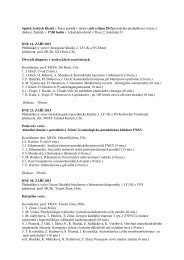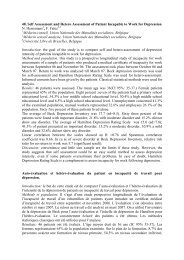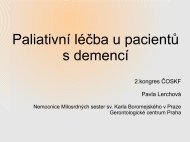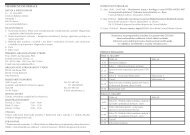ABSTRACTS â ORAL PRESENTATIONS - AMCA, spol. s r.o.
ABSTRACTS â ORAL PRESENTATIONS - AMCA, spol. s r.o.
ABSTRACTS â ORAL PRESENTATIONS - AMCA, spol. s r.o.
Create successful ePaper yourself
Turn your PDF publications into a flip-book with our unique Google optimized e-Paper software.
was harmful neither alone nor in combination to normal cells, which can be a possible<br />
rationale for future clinical trials.<br />
Acknowledgements<br />
This work was supported by MŠMT grant CZ.1.07/2.3.00/30.0030, by MZD grant<br />
NT13573-4/2012; by the AVCR grant AV0Z50040702, and by the project FNUSA-ICRC<br />
CZ.1.05/1.1.00/02.0123 from the European Regional Development Fund.<br />
References<br />
Guzi, T.J., et al.: Targeting the replication checkpoint using SCH 900776, a potent and<br />
functionally selective CHK1 inhibitor identified via high content screening. - Mol Cancer<br />
Ther,10(4): 591-602, 2011<br />
P33. THE EFFECTS TO MOLECULAR BIOMEMBRANE TRANSPORT HYPERFORIN OR<br />
ARISTOFORIN IN COLON ADENOCARCINOMA CELLS<br />
Martina Šemeláková, Rastislav Jendželovský, Jaromír Mikeš, Peter Fedoročko<br />
Institute of Biology and Ecology, Faculty of Sciences, P.J. Šafárik University in Košice,<br />
Slovak Republic; martina.semelakova@upjs.sk<br />
Photodynamic therapy is an anti-cancer approach for the treatment of various types<br />
of non-malignant as well as malignant diseases. Hypericin (HY), a naturally-occuring<br />
photosenzitive compound synthesized by Hypericum sp. (St. John’s wort), posses<br />
properties suitable for PDT and demonstrates photocytotoxic activity both in vitro and<br />
in vivo (Agostinis et al., 2000). Hyperforin is a phloroglucin-derivative that has emerged<br />
as a key player not only in the antidepressant activity of the plant’s extract but also as<br />
a suppressor of bacteria, lymphocyte and tumor cell proliferation (Erdelmeier, 1998),<br />
and as an inhibitor of matrix proteinases. Aristoforin, however, one of hyperforin’s<br />
synthetically prepared derivatives, has proved to be more soluble and even stable in<br />
aqueous solution. Importantly, it retains the antitumor properties of the parental<br />
compound without inducing toxicity in experimental animals. These data strongly<br />
suggest that AR has even greater potential as an anticancer drug (Gartner et al., 2005).<br />
Our previous results (Semelakova et al., 2012) showed that hypericin (HY)-mediated<br />
photodynamic therapy (HY-PDT) in sub-optimal dose with hyperforin (HP) (both bioactive<br />
compounds naturally occuring in plants of Hypericum sp.), or its stable derivative<br />
aristoforin (AR) were able to stimulate mechanisms leading to significant antitumor<br />
activity. Both, HP or AR were used at relatively low concentrations up to 5 μM. Significant<br />
accumulation of HY in cells after 16 h of incubation with drugs was described.<br />
Generally, the therapeutic efficacy of various chemotherapeutics is severely limited by<br />
drug resistance that is related to overexpression of drug efflux transporters in tumour<br />
cells. Therefore the impact of HY, HP or AR on cell’s ATP-binding cassette membrane<br />
transporter system, namely multidrug resistance-associated protein 1 (MRP1/ABCC1)<br />
and 2 (MRP2/ABCC2), breast cancer resistance protein (BCRP), P-glycoprotein (P-gp/<br />
MDR1) and cytochrome P450 monooxygenase, was subsequently evaluated by Western<br />
blot analysis of proteins, mRNA expression by qRT-PCR and flowcytometric analysis of<br />
126 Analytical Cytometry VII








